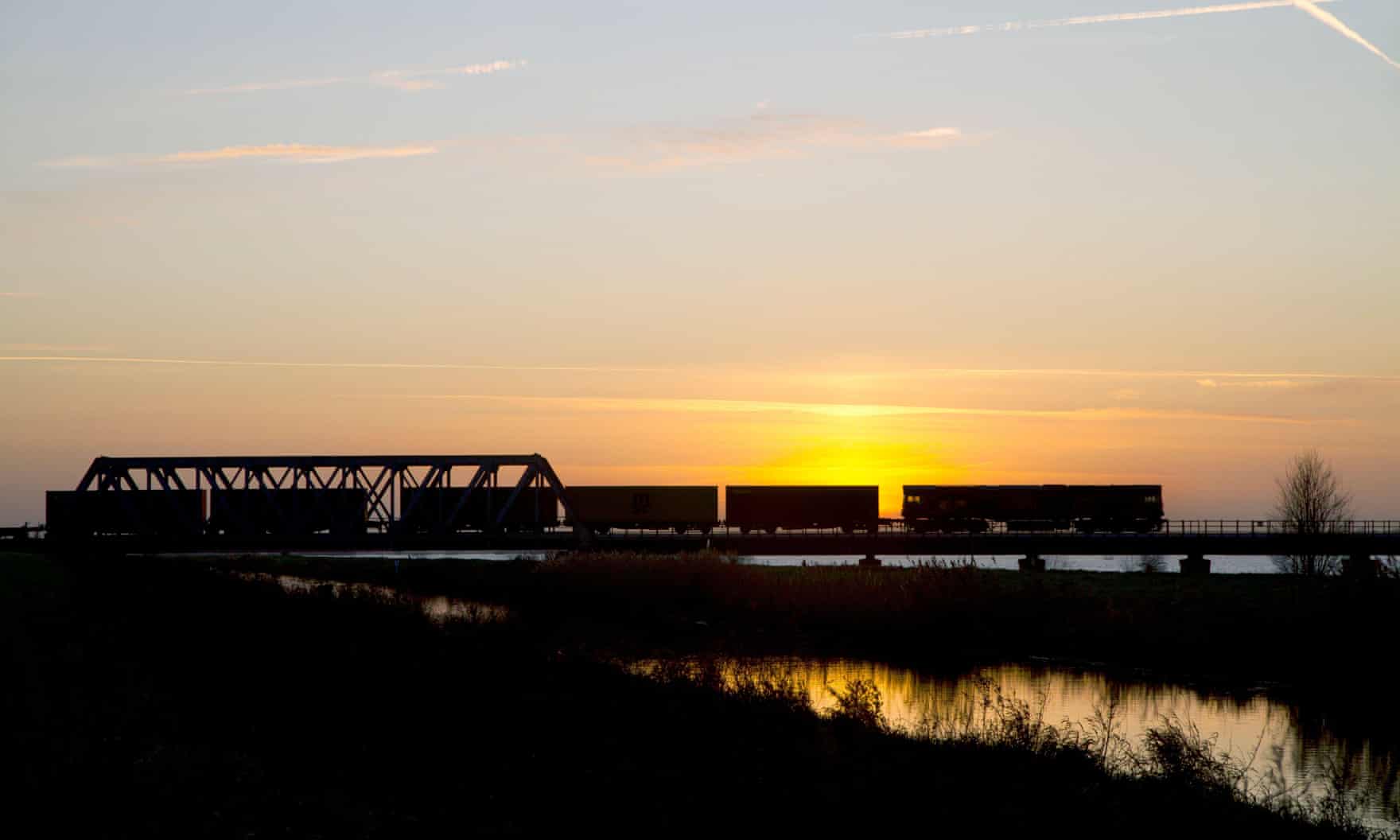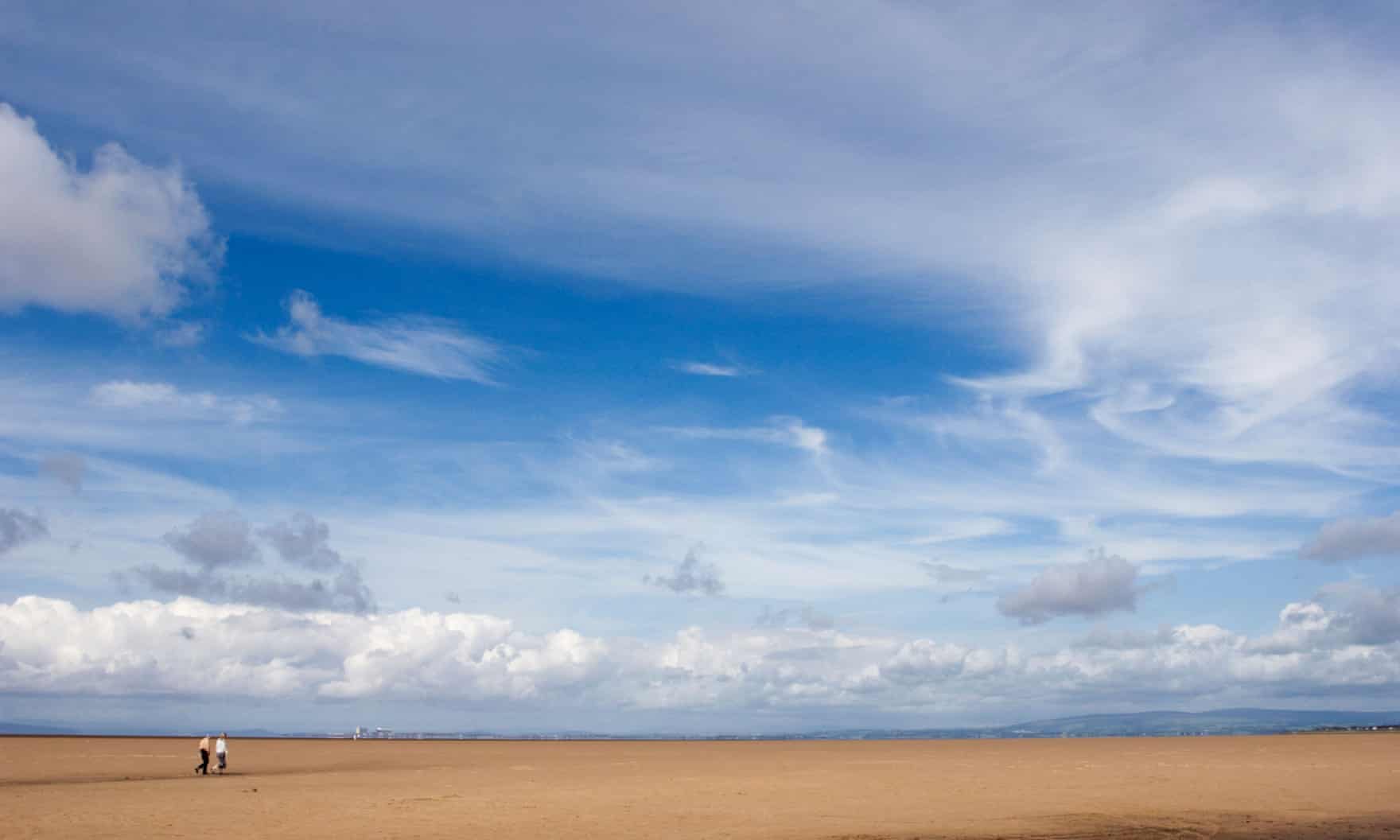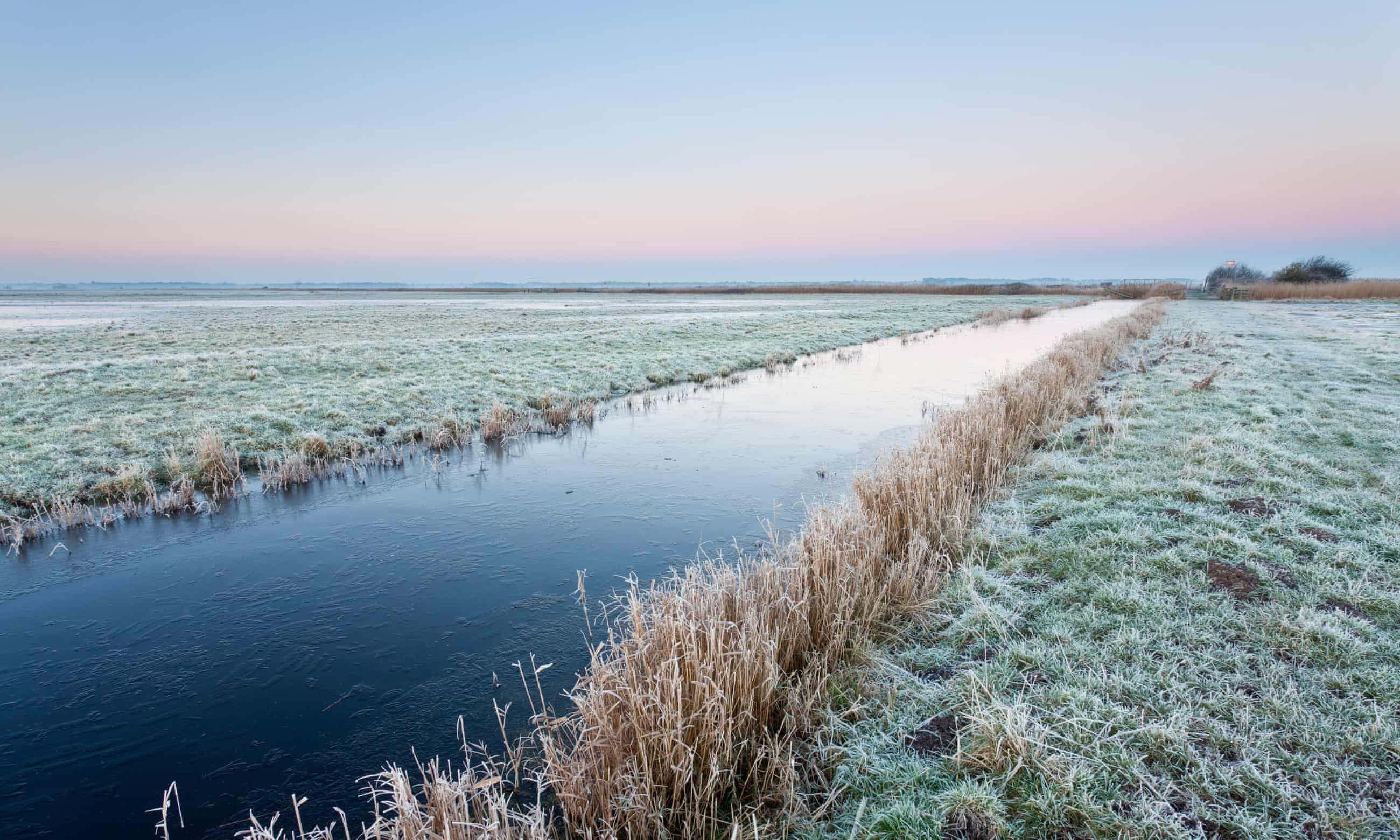Shingle beach, drained farmland or a bare plain under huge skies; flat spaces distort distance and make me want to run and yell
Noreen Masud
If you visit the flat fenlands of Cambridgeshire on a clear day, and walk along the ruler-lined channels and droves, you might – if you’re lucky – see a freight train pulling itself out of the horizon like a conjuror’s endless scarf. Stand and watch, as long as you can. The train traces the top of the level land, wagon by coloured wagon, until the whole distance is trimmed with its purpose. Your attention will drift off, and drift back in, and that train will still be there, streaming along. And even when you can no longer hear its roar – when the wind’s slap of silence takes over your ears again – you’ll still be able to see the freight carriages, taking their time to vanish from that bare landscape.We don’t talk much about Britain’s flat places. From the Cambridgeshire fens to the West Lancashire coastal plain, we pass over them hurriedly, looking for forests or rivers or mountains. Flat places seem hardly to count as places. They’re just the gaps between landmarks. If people think about flatlands at all, it’s usually to call them boring. Nothing to look at, nothing to focus on, no hidden places to discover. To be flat is to be dull: a cut-and-dried equation. So in Noël Coward’s play Private Lives (1930), divorcee Amanda demolishes her ex-husband’s new wife – met at a party in East Anglia – with the bland statement: “Very flat, Norfolk.” Norfolk has been trying to live this down ever since. “There are a lot of misperceptions about Norfolk,” pleads the Visit Norfolk website, “not least that the county is flat, far away and the weather isn’t great. Read on and we’ll debunk them all …”

But Norfolk doesn’t need to woo me with undulations. Its Beacon Hill and Beeston Bump leave me cold. Because whether it’s drained farmland, shingle beach or bare moor, I love flat landscapes more than any other. In 2021 and 2022, I travelled around some of Britain’s flattest landscapes – Cambridgeshire, Suffolk, Morecambe Bay, Orkney, Newcastle Moor – and I’m still not tired of them. Flat places continue to seduce me. Go to any beach when the tide is out, and you get a taste of their magnificence. You don’t need golden sands: mud will do perfectly. The point is to find that ruler-straight line of the horizon, cut with such confidence and swagger against the big sky. When I gaze at a flat space, a weight falls from me and energy rises up through my body. I feel utterly free in body and mind; I want to run and yell and cartwheel.
If you feel strange in the world – a little bit alien, perhaps, as so many of us do – you might find a home for yourself in flat places. As I discovered, watching that freight train run through the Cambridgeshire fens in 2021, the smallest things become weird in a flat place. Normal rules are suspended. Without landmarks to ground me, time and distance warped and shrank. A faraway white seagull seemed the size of a sheep; speck-like human figures loomed large with bewildering speed. Flat landscapes even invite mirages, those false glimmers of water luring thirsty travellers in the desert. No wonder, therefore, that flat places such as the Somerset Levels are rich with myth and folklore. King Arthur lingers in the Avalon Marshes. Hereward the Wake leaves his trail from Oakham to Thetford. When I find myself in a flat landscape, this magic tingles through my body. What is strange in me starts to feel special.

When you stand in these spaces, a sense of power fights with vulnerability. On one hand, you’re the tallest thing in the landscape. On the other – without the shelter of trees and hills – you’re wholly unprotected. You can see anything or anyone coming for miles – but equally, they can see you too. And these spaces bring up bigger philosophical questions, if we let ourselves notice them: how do we look at a flat landscape at all? What do we focus on, in a space with no landmarks? No wonder people often find flat landscapes frightening. They trouble our sense of our own importance, and our confidence about how we interact with our environments.
So the western reaction to flat landscapes, historically, has been to get rid of them. To build on them; to colonise them (think of the frontier myth in North America); to disrupt their inscrutable weirdness. But flat places have also goaded people into art: to working with, not against, the strange levelness. Flat expanses appear again and again in the work of eccentric or outsider artists: Craigie Aitchison’s crucifixion scenes, LS Lowry’s seascapes, Georgia O’Keefe’s prairies and clouds. And the landscapes themselves make room for art, ceremony and ritual. It’s hard for me not to see Orkney’s standing stones as a response to its vast bare stretches. Faced with those exquisite horizontals, people thousands of years ago erected tall stones as counterpoints, emblems of the perfectly vertical. Rather than challenging the flatness, these 90-degree slates create accent, allowing the flat islands to seem more themselves.

At the other end of Britain, in one of my very favourite landscapes – Shingle Street, a divinely flat shingle beach in Suffolk – friends Lida Cardozo Kindersley and Els Bottema, resting together from the exigencies of cancer treatment, made a line of white whelk shells that stretched almost three hundred metres. The landscape made space for them to play, experiment and simply be: in return, the Shingle Street shell line wound through the shingle without overwriting it.

Most existing level landscapes in the UK were recovered, painstakingly, from water. The fens of East Anglia were drained in the 17th century, at tremendous expense. And, of course, that water keeps trying to come back: towns such as March, 17 miles east of Peterborough, flood more and more often as the climate shifts. It’s the same in flat landscapes across Britain. The magnificent glittering flatness of Morecambe Bay, in the north-west, is only ever a temporary delight; every day the water rushes back in, reclaiming its rightful property, keeping the flatland safe from development. The sea tactfully covers and recovers breathtaking expanses: it gives us a peep now and then, but knows we can’t be trusted with them for long. So stop and look, next time you see a flat place. Let your eye run out over the expanse, relaxed, intent without purpose. Feel that strong, unapologetic horizon line like a sensation in your body. It’s weird and alien, but so are you.
Noreen Masud is author of A Flat Place is published by Penguin (£16.99). To support the Guardian and Observer order your copy at guardianbookshop.com. Delivery charges may apply
Source: I’ll level with you – I truly love Britain’s flat landscapes | England holidays | The Guardian
